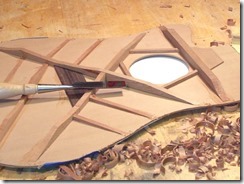
No Throwaways
 When I am building an acoustic guitar, I mess up all the time. This is always frustrating, though I am learning that it is also natural. Even the best, most experienced luthiers mess up. I don’t like to take pleasure in another person’s misfortune, but I am actually encouraged by this. It tells me that it’s a normal part of the process and not wholly a result of my incompetence.
When I am building an acoustic guitar, I mess up all the time. This is always frustrating, though I am learning that it is also natural. Even the best, most experienced luthiers mess up. I don’t like to take pleasure in another person’s misfortune, but I am actually encouraged by this. It tells me that it’s a normal part of the process and not wholly a result of my incompetence.
We mess up because no two pieces of wood are the same. We mess up because a sharp chisel not only makes it easy to carve what you want but also what you don’t want. We mess up because power sanders can remove a lot of material very quickly, sometimes before you realize that you’ve gone too far.
We also mess up because each part of the process demands our complete attention, and sometimes we are distracted by phone calls, problems at work, or that argument we just had with our spouse or teenager.
When things do go wrong, I have to ask myself, “Do I scrap this and start all over, or can I fix it?
Guitar tops—the part with the hole in it—come too thick and have to be thinned or else they won’t vibrate enough to create sound. The wood needs a certain amount of floppiness to get that sound, but if it is too floppy it will not only lose some of its musicality but will be too weak to withstand the 150-175 pounds of pull that the strings exert on the top.
One of the guitars I am building right now has a cedar top, and it’s the first time I’ve built with cedar. Normally I use spruce, which is stronger than cedar and has to be thinner. With this first cedar top I wasn’t as careful as I needed to be and I thinned the it too much. It’s musical, but it’s too weak. After a few years the strings will pull up on the wood so much that a hump will form under the bridge; eventually the bridge will come off and probably take some of the wood with it.
There was nothing that I could do to fix this. I had to get another piece of cedar and start all over. The old top is essentially useless.
Throwing away a $60 guitar top is no fun.
On another guitar I was routing the ledge for the binding—the decorative piece of wood on the side edges of the guitar—when the router bearing came loose and fell off, the result being that the router gouged a quarter-moon about 3/8” into the back of the guitar. At first I thought that I would have to cut the back off the guitar and make a entirely new one. I was so frustrated that I had to turn off the lights and leave. The next morning, however, I realized that this could be fixed.
I had kept the off-cut from the back—the wood leftover after I cut the back out—so I retrieved it, found the section next to where the gouge was, and cut that section out. I then matched the grain as closely as possible, traced the shape of the gouge onto that section, and cut it out. Careful sanding and shaping left me with a patch that fit perfectly. After gluing it in, you couldn’t tell it’s there. I can find it, but nobody else can. (Click here to see the fix.)
Redeeming that back was definitely better than discarding it.
Part of the Original Sin that infects humanity is that we lack the ingenuity, will, and perseverance required to redeem situations and people. We are too quick to determine that certain types of sinners are without hope, that conflicts with other nations or groups can’t be resolved without someone having to die, that the greed of the rich and the hopelessness of the poor will never end, so what’s the point of even trying? And our theology reflects this; too many Christians believe that, in the end, God will just destroy this mess, and the lucky few who take the narrow road will by grace get to live out eternity in heaven.
Don’t believe it. That is not resurrection theology. The Good News is that the God who is able to bring back to life that which is dead is not powerless in the face of sin. He is a powerful God who is able, not merely to destroy what is evil and hopeless, but to redeem what is evil and hopeless.
 I am a lifelong student of the Bible, and have been a pastor for over twenty-five years. My desire through this blog is to help people see things in the intersection of Scripture and real life that they might have missed. The careless handling of the Bible is causing a lot of problems in our churches and our culture--and is literally turning people away from the church, and, sometimes, God. I hope to treat Scripture with the respect it deserves, and, even if you don't agree with what I say, give you some insight.
Feel free to leave a comment. I promise to respond to you. All I ask is that you be respectful in your comments.
I am a lifelong student of the Bible, and have been a pastor for over twenty-five years. My desire through this blog is to help people see things in the intersection of Scripture and real life that they might have missed. The careless handling of the Bible is causing a lot of problems in our churches and our culture--and is literally turning people away from the church, and, sometimes, God. I hope to treat Scripture with the respect it deserves, and, even if you don't agree with what I say, give you some insight.
Feel free to leave a comment. I promise to respond to you. All I ask is that you be respectful in your comments. 
Connect with Me